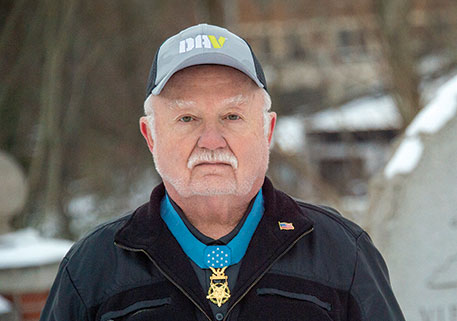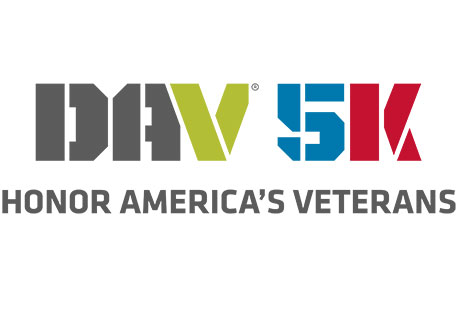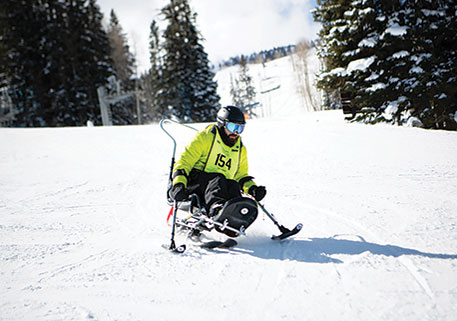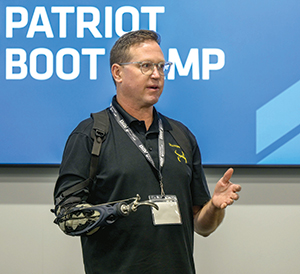
Marine Corps veteran Jonathan Kuniholm couldn’t wait to try out the kind of thought-controlled bionic arm he had read so much about during convalescent leave.
Only weeks before, during a foot patrol in Haditha, Iraq, on New Year’s Day 2005, an improvised explosive device nearly severed his right arm below the elbow. He had every right to grieve, but as a Marine and engineer, Kuniholm quickly shifted into problem-solving mode.
He researched prosthetic technology and felt encouraged by the medical advancements so often hailed in media reports. He was convinced he would get the best of the best at what is now Walter Reed National Military Medical Center—and he did.
But Kuniholm soon learned that the best wasn’t all it was cracked up to be. Now, nearly 20 years later, he has designed a product that could revolutionize prostheses for arm amputees.
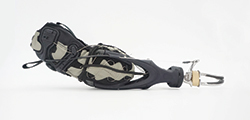 Last fall, Kuniholm donned his creation while participating in DAV Patriot Boot Camp, a multiday program designed to support entrepreneurs from the veteran- and military-connected community. The event welcomed a cohort of nearly 50 founders and 50 mentors to DAV National Headquarters in Kentucky. Kuniholm, a DAV member of Chapter 1 in Portland, Oregon, was there representing StumpworX, his business venture dedicated to improving prosthetic arm technology.
Last fall, Kuniholm donned his creation while participating in DAV Patriot Boot Camp, a multiday program designed to support entrepreneurs from the veteran- and military-connected community. The event welcomed a cohort of nearly 50 founders and 50 mentors to DAV National Headquarters in Kentucky. Kuniholm, a DAV member of Chapter 1 in Portland, Oregon, was there representing StumpworX, his business venture dedicated to improving prosthetic arm technology.
It may have been surprising to see Kuniholm using a body-powered split hook almost identical to the one designed in 1912 by D.W. Dorrance. After trying several iterations of more modern, high-tech arms in 2005, Kuniholm realized the Dorrance hook was hard to beat.
“That rubber band and a hook on the end of the stick is actually really capable,” he said.
With sensors that attach to muscles and ends that mimic hands and fingers, myoelectric arms grab headlines and research dollars for their realistic look and futuristic promise. But those prostheses are actually less comfortable and less functional than their body-powered counterparts.
So Kuniholm turned his focus to the end of the stick that had been neglected for far too long: the socket.
“[The conventional socket] is a lot like wearing a Dutch wooden shoe with a rubber sock,” Kuniholm explained.
In fact, the socket—not the arm or the hand—is responsible for the majority of arm amputees’ complaints when it comes to wearing and using a prosthesis.
“The sockets, if you get a bad fit, it can be excruciating,” said Marine Corps veteran Tim Kolich.
Kolich lost his right arm below the elbow while serving in Vietnam and has worn a body-powered Dorrance hook with a traditional socket for 55 years. When he was his most active, water skiing and whitewater boating, he experienced just how problematic the socket can be—even with a “good” fit.
“You can imagine with that hard socket, you’re in a river all day paddling kayaks and rubber boats, that stump could get pretty damp, pretty soft, and blister,” Kolich said. “I had days when the end of that stump was blistered and it was bloody.”
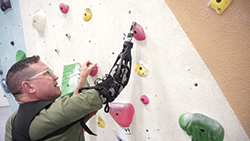
Kuniholm said that’s why so many arm amputees will either forgo wearing a prosthesis or avoid physical activity. Kolich, who is in the early stages of testing out the StumpworX socket, believes that what Kuniholm has created can change the game.
“This device, it looks like it could circumvent [the issues I had in my younger days],” Kolich said.
Using athletic shoe materials that were proven to address similar challenges, Kuniholm made a textile-based socket that’s comfortable, breathable and absorbent while allowing for a full range of motion. Kuniholm has tested the socket while rock climbing, skiing and biking, all with much success.
Kuniholm said he could start delivering his socket to arm amputees right now. The challenge is getting the funding to manufacture a product that serves a relatively small population and doesn’t promise big financial returns. Most of his research and development has been self-funded, and he’s pursuing grant dollars through the Department of Veterans Affairs.
“My hope is that we could initially set up manufacturing of this within the VA,” he said. “I would love to provide every single one of the 5,000-some veterans in the VA system who are missing arms with one of these devices.”
Kuniholm turned to DAV Patriot Boot Camp to network with fellow veterans and entrepreneurs and to connect with successful business experts from various industries and specialties. Those connections have proven fruitful for countless program alumni.
In fact, as a pitch contest finalist at the event and the top recipient at the DAV pitch contest, which was hosted digitally, Kuniholm earned $1,500 in non-dilutive capital and received one-on-one pitching mentorship—a resource that could help him succeed with his goal to improve the quality of his fellow veterans’ lives.
“Jonathan’s determination to leverage innovation and entrepreneurship in a meaningful way represents exactly what DAV Patriot Boot Camp is about,” said DAV Chief Communications and Outreach Officer Dan Clare. “This community will continue to support his mission in any way it can, and we look forward to watching Jonathan transform prosthetics.”
Learn more about DAV Patriot Boot Camp and sign up for notifications of upcoming events at patriotbootcamp.org. For inquiries about StumpworX, visit stumpworx.com.

